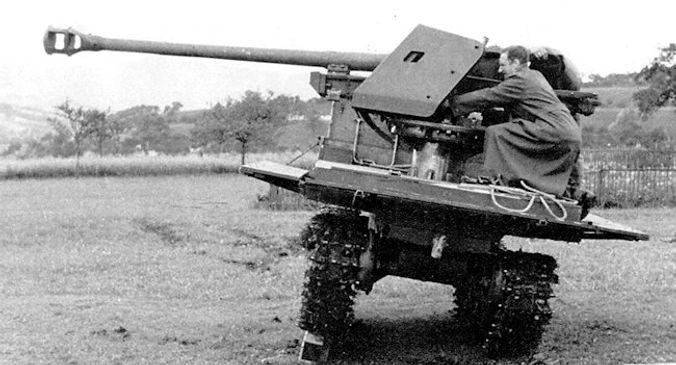

Pak 40 75MM mounted to a Raupenschlepper Ost Ammunition Carrier
Pak 40 75MM mounted to a Raupenschlepper Ost (RSO) ammunition carrier in Panzerjäger configuration.
This Panzerjäger, Tank Hunter, is an improvised self-propelled anti-tank gun created by Germans in 1943 due to a desperate need for more self-propelled anti tank guns. It was done by simply installing a 75 mm PAK 40 on an RSO ammunition carrier chassis. The RSO or Raupenschlepper Ost was introduced in 1942 and was initially designed as a prime mover and artillery supply vehicle, it eventually served in a wide variety of roles. Immediately after the vehicle reached the Eastern front, the combat units started using it for general transport duties and towning. The RSO was a contemporary with similar Allied full-tracked small artillery tractors in use in other armies such as the Soviet STZ-5 "Stalingradets", and the U.S. Army's M4 Tractor.
It gave outstanding service as a cargo carrier and towing vehicle due to its reliability, its ease of maintenance due to a simpler suspension system, and its capability to take over a variety of roles particularly in poor terrain that other larger vehicles like the Sdkfz7 half track lacked but it was found that when towed behind a regular RSO the gun optics could be damaged so it was decided to combine both gun and vehicle.
The RSO was already used to tow the PAK 40 gun to improve the mobility and off-road ability of the anti-tank teams, so it was readily available for use in the conversion by 1943, particularly on the Eastern Front against the Russians. OKW, Oberkommando der Wehrmacht, the German high command, began looking to convert the vehicles into gun carriers themselves, rather than just using them for towing. (1)

In order to give the vehicle a lower silhouette from the much higher original 55CM chosen for high ground clearance in the support roles and allow forward firing arcs for the gun the cabin was simply sawn off from the RSO by Steyr, the company creating the conversions, leaving the crew cabin totally exposed from the waist up and the original RSO itself had zero armour so an rifle protection level armoured nose was added just high enough to protect up to the waist of the driver and commander while the rest of the gun crew would use the unmodified PAK 40's gun shield for protection. Despite these efforts the vehicle was still very high and exposed, and the armour was nearly worthless.
Originally intended as a very cheap and easy conversion to improve mobility compared to moving the PAK guns by foot or light unarmoured trucks, Adolf Hitler ordered the self-propelled PAK vehicles into combat use on October 1st 1943 before they had even finished prototyping and finalising the design.
It was used in combat in small numbers by Panzerjager Abteilungen 743 and 744, and the 18th Panzergrenadier Division in January 1944. Some were sent to the 1st Ski-jäger Brigade, and some were sent to Army Group North, to Armee-Pz. Jägerabteilungen 751 and 752. In the 1st Ski Jäger Brigade, the RSO with Pak 40 was incorporated into the 13th Panzerjäger-Flak company, where it was deployed in 2 platoons with an infantry escort platoon. (2)
In actual combat use, this vehicle was said to be less than desirable. It was slow, noisy and the engine had a tendency to overheat in warm weather. The lack of armor and high silhouette was also an issue, as many crews were lost when they attracted fire of any kind.
The small fighting platform made it difficult to operate the PAK 40 gun, and the floor lockers for ammunition storage were difficult to open when the weapon was in use. The vehicle earned the nickname “Rollender Sarg Ost”, a play on the RSO abbreviation. This nickname translates to “rolling coffin east”, reflecting the thoughts of the soldiers who operated it and less than 60 to 100 were converted into PAK 40 gun carriers.
Despite it's dismal performance plans for an upgraded variant to be named Pz.Jäg. K43. existed, which would be a RSO carrier more extensively modified with a more powerful but also quieter V8 engine and a widened chassis for improved cross-country performance and a lowered the centre of gravity, a problem in a vehicle of such a high ground clearance. It would also able to mount the 88MM PaK 43 L71 gun but the planned 88MM upgraded version never left the drawing board after Steyr was ordered by the Ministry of Munitions to cease production of any type of tracked vehicles and shift to other productions. (3)
1- 7,5cm Pak40/4 auf Selbsfahrlafette RSO , Material Ministries
2- Pak 40 auf Raupenschlepper Ost (tanks-encyclopedia)
3- Raupenschlepper OST Steyr (Catalog of Enemy Ordnance, U.S. Office of Chief of Ordnance, 1945)